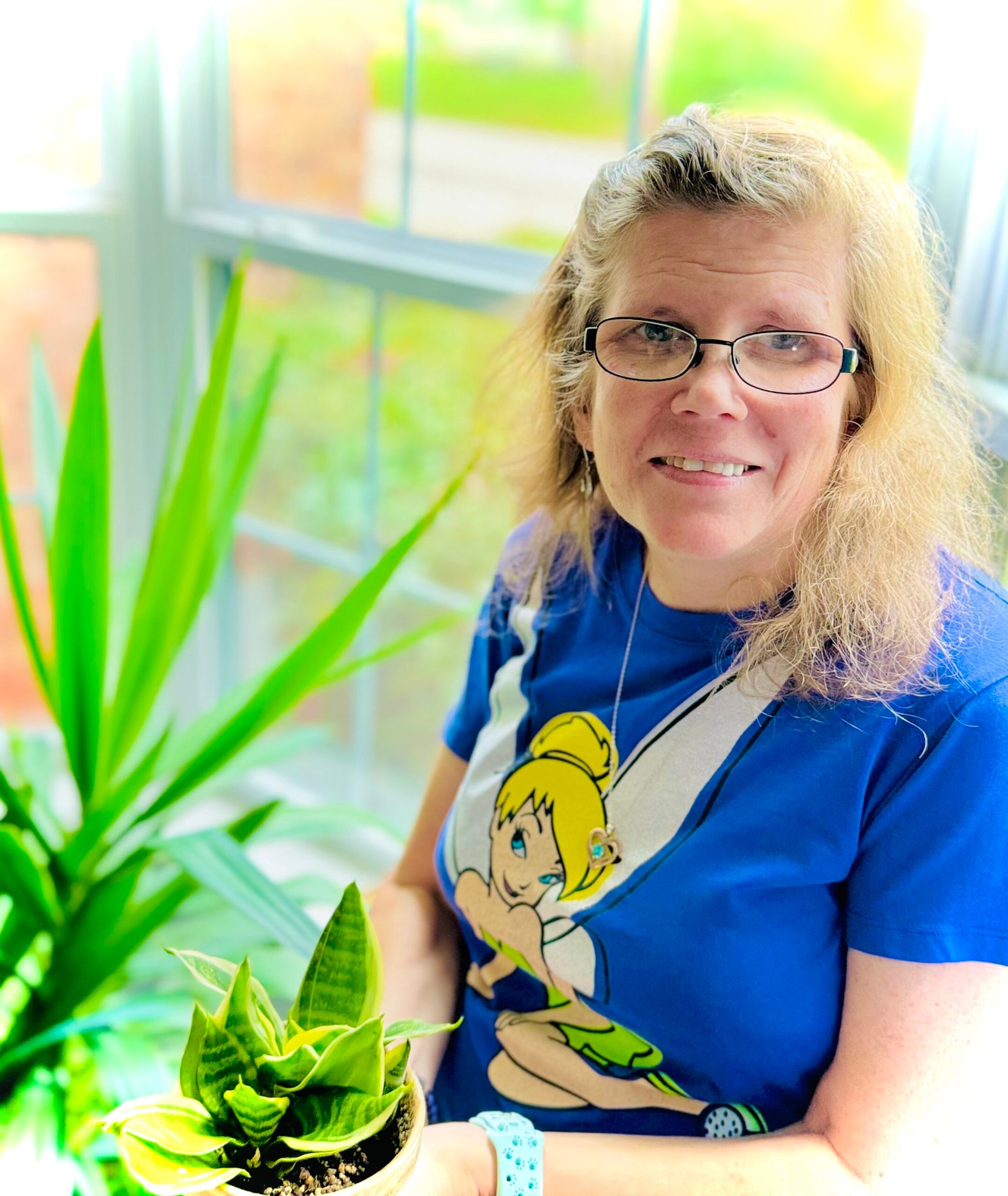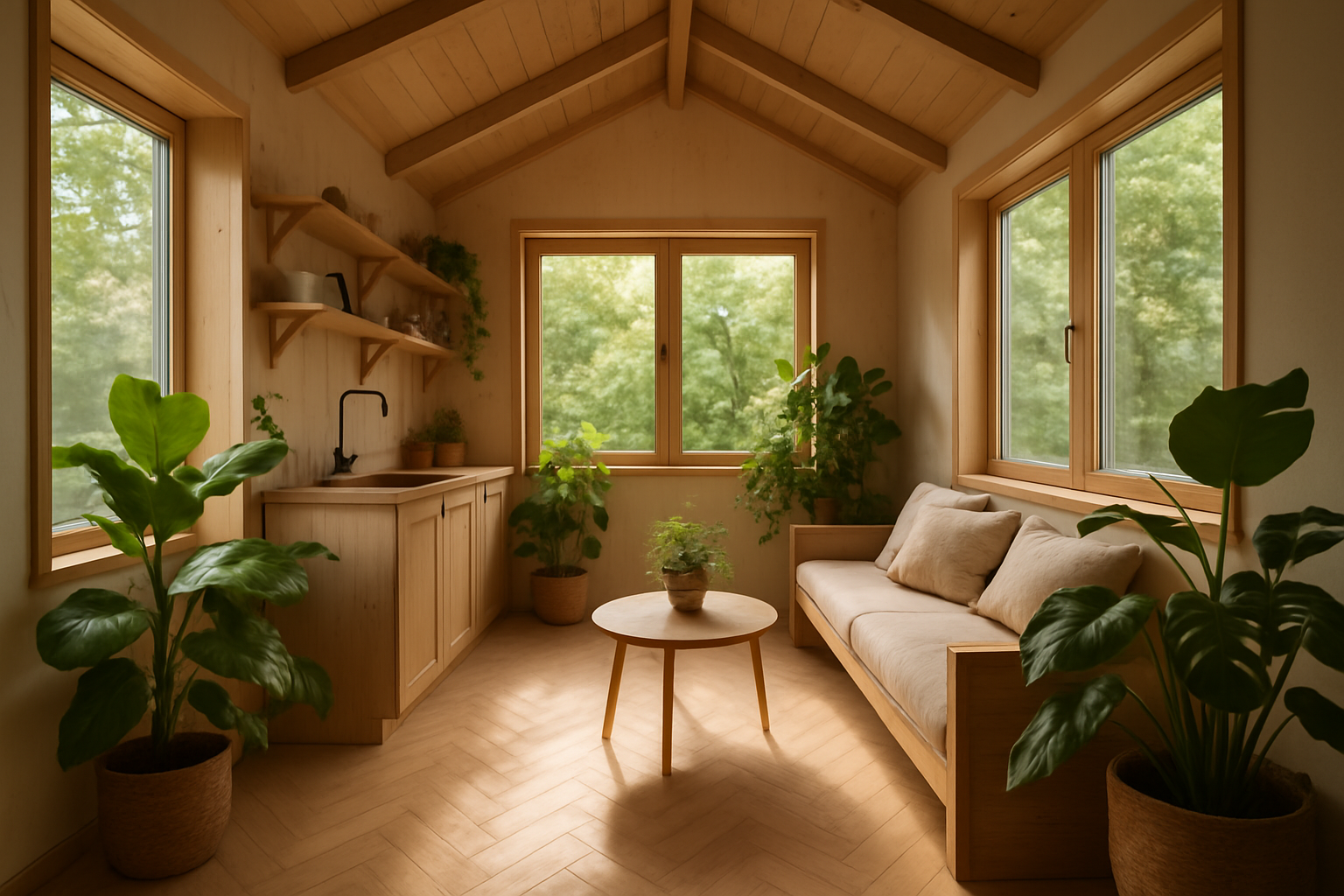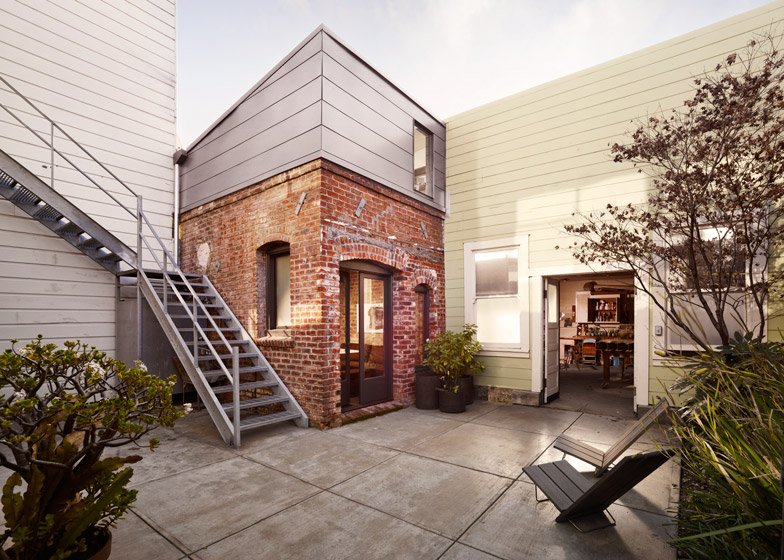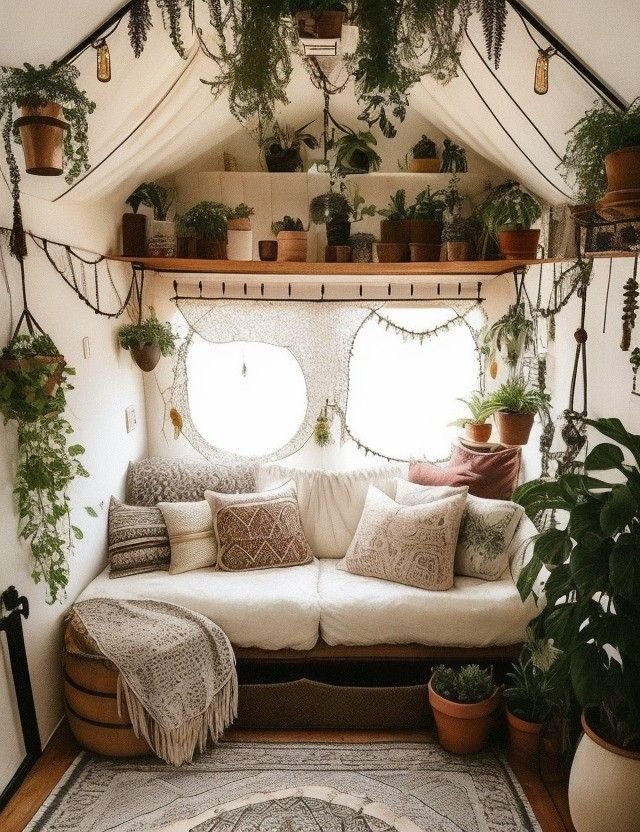
A stunning example of Earthy Boho Tiny House Interiors design in a tiny house, featuring natural materials and warm, inviting textures.
The bohemian design movement has experienced an unprecedented surge in popularity, with searches for “Earthy Boho Tiny House Interiors” skyrocketing by an astounding 335% in recent months. This dramatic increase reflects a growing desire among homeowners to create spaces that feel authentically connected to nature, deeply personal, and refreshingly unconventional. For tiny house dwellers, the earthy boho aesthetic offers the perfect solution to transform compact living spaces into warm, inviting sanctuaries that maximize both style and functionality without sacrificing the free-spirited essence that defines bohemian design.
Earthy boho style represents a sophisticated evolution of traditional bohemian decor, emphasizing natural materials, earth-toned color palettes, and sustainable design choices that create harmony between indoor and outdoor living. Unlike its more vibrant bohemian cousins, earthy boho embraces muted terracotta, sage greens, warm browns, and creamy neutrals that make small spaces feel larger while maintaining the eclectic, layered aesthetic that boho enthusiasts love. This approach proves particularly effective in tiny houses, where every design decision must serve multiple purposes and contribute to an overall sense of spaciousness and tranquility.
The appeal of earthy boho design in tiny houses extends far beyond mere aesthetics. This style philosophy aligns perfectly with the tiny house movement’s core values of sustainability, mindful living, and connection to nature. By incorporating natural textures, handcrafted elements, and vintage finds, tiny house owners can create interiors that tell personal stories while maintaining the relaxed, lived-in feeling that makes a house truly feel like home. The earthy boho approach also offers practical advantages for small space living, as its emphasis on layered textiles, multi-functional furniture, and creative storage solutions helps maximize every square inch while creating visual interest and depth.
Embracing Earthy Boho Tiny House Interiors allows for a unique blend of comfort and creativity, making each tiny space a reflection of personal style.
Understanding Earthy Boho Style in Tiny Houses Understanding-earthy-boho-style
Earthy boho style represents a refined interpretation of bohemian design that prioritizes natural elements, sustainable materials, and a connection to the earth over the more eclectic and colorful traditional boho aesthetic. This design philosophy proves particularly well-suited to tiny house living, where the emphasis on natural materials and organic textures helps create a sense of spaciousness and tranquility that can make even the smallest spaces feel like expansive retreats.
The foundation of earthy boho design rests on the principle of bringing the outdoors inside through carefully curated natural elements. Unlike traditional bohemian style, which often embraces bold colors and dramatic patterns, earthy boho focuses on creating harmony through subtle variations in texture, tone, and material. This approach allows tiny house dwellers to achieve the relaxed, free-spirited feeling of bohemian design without overwhelming their limited square footage with visual chaos.
In tiny houses, earthy boho style serves multiple practical purposes beyond pure aesthetics. The emphasis on natural materials like jute, linen, wood, and stone creates a cohesive visual flow that makes spaces appear larger and more connected. The neutral color palette associated with earthy boho design reflects light more effectively than darker, more saturated colors, helping to brighten small interiors and create an airy feeling that counteracts the potential claustrophobia of compact living.
For more insights on creating cohesive color schemes in small spaces, explore our comprehensive guide on Tiny House Color Palettes & Mood Boards, which provides detailed strategies for maximizing the visual impact of color in compact interiors.
Essential Color Palettes for Earthy Boho Tiny Homes Essential-color-palettes
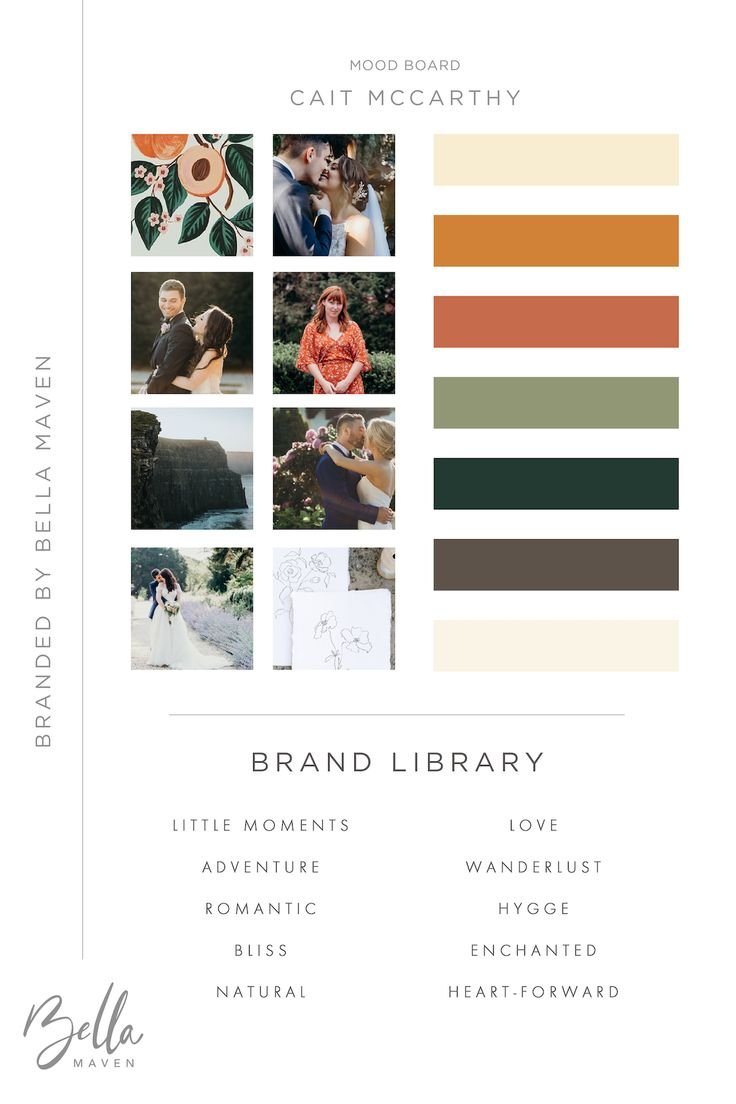
A carefully curated earthy boho color palette featuring warm neutrals, terracotta, sage green, and natural wood tones.
The color palette forms the backbone of any successful earthy boho tiny house interior, serving as the foundation upon which all other design elements build. Unlike traditional bohemian style, which often embraces jewel tones and saturated colors, earthy boho palettes draw inspiration from natural landscapes, incorporating the subtle variations and harmonious relationships found in nature. These carefully chosen color schemes not only create the relaxed, organic feeling characteristic of the style but also serve practical purposes in tiny houses by making spaces appear larger, brighter, and more cohesive.
The primary earthy boho palette centers around warm neutrals that evoke the feeling of sun-baked earth and natural stone. Creamy whites, soft beiges, warm grays, and mushroom tones provide a sophisticated backdrop that allows other elements to shine without competing for attention. These neutral foundations prove particularly valuable in tiny houses, where lighter colors help reflect available light and create the illusion of expanded space.
Terracotta and clay tones represent perhaps the most iconic colors in the earthy boho palette, bringing warmth and richness to tiny house interiors without overwhelming small spaces. These earthy oranges and deep peaches can be introduced through accent walls, pottery, textiles, or artwork, creating focal points that add visual interest while maintaining the natural, grounded feeling essential to the style.
According to Architectural Digest, earth tones have seen a 40% increase in popularity among interior designers in 2024, making them a trending choice for modern homes. This trend aligns perfectly with the growing interest in sustainable, nature-inspired design that characterizes the earthy boho movement.
Natural Materials and Textures That Define the Look Natural-materials-and-textures
The heart of earthy boho design lies in its celebration of natural materials and organic textures that bring the beauty and tranquility of the outdoors into tiny house interiors. These materials not only define the aesthetic character of the style but also serve practical purposes in small spaces, providing durability, sustainability, and sensory richness that makes compact living more comfortable and appealing.
Wood serves as perhaps the most fundamental natural material in earthy boho tiny house design, providing warmth, character, and structural beauty that forms the backbone of the aesthetic. Reclaimed wood, with its weathered patina and visible history, proves particularly valuable for creating the authentic, lived-in feeling that defines the style. In tiny houses, wood can appear in multiple forms, from exposed ceiling beams and shiplap walls to floating shelves and handcrafted furniture pieces.
Jute and sisal represent essential natural fibers that bring texture and warmth to earthy boho tiny house floors and walls. These durable, sustainable materials work particularly well in small spaces because their neutral tones and organic textures complement rather than compete with other design elements. Jute rugs provide an excellent foundation for layering other textiles, while sisal wall coverings can add subtle texture and sound absorption that improves the acoustic comfort of tiny house interiors.
For those interested in incorporating more rustic farmhouse elements into their earthy boho design, natural materials like weathered wood and stone can bridge these complementary styles beautifully.
Layered Rugs: The Foundation of Boho Style Layered-rugs-foundation
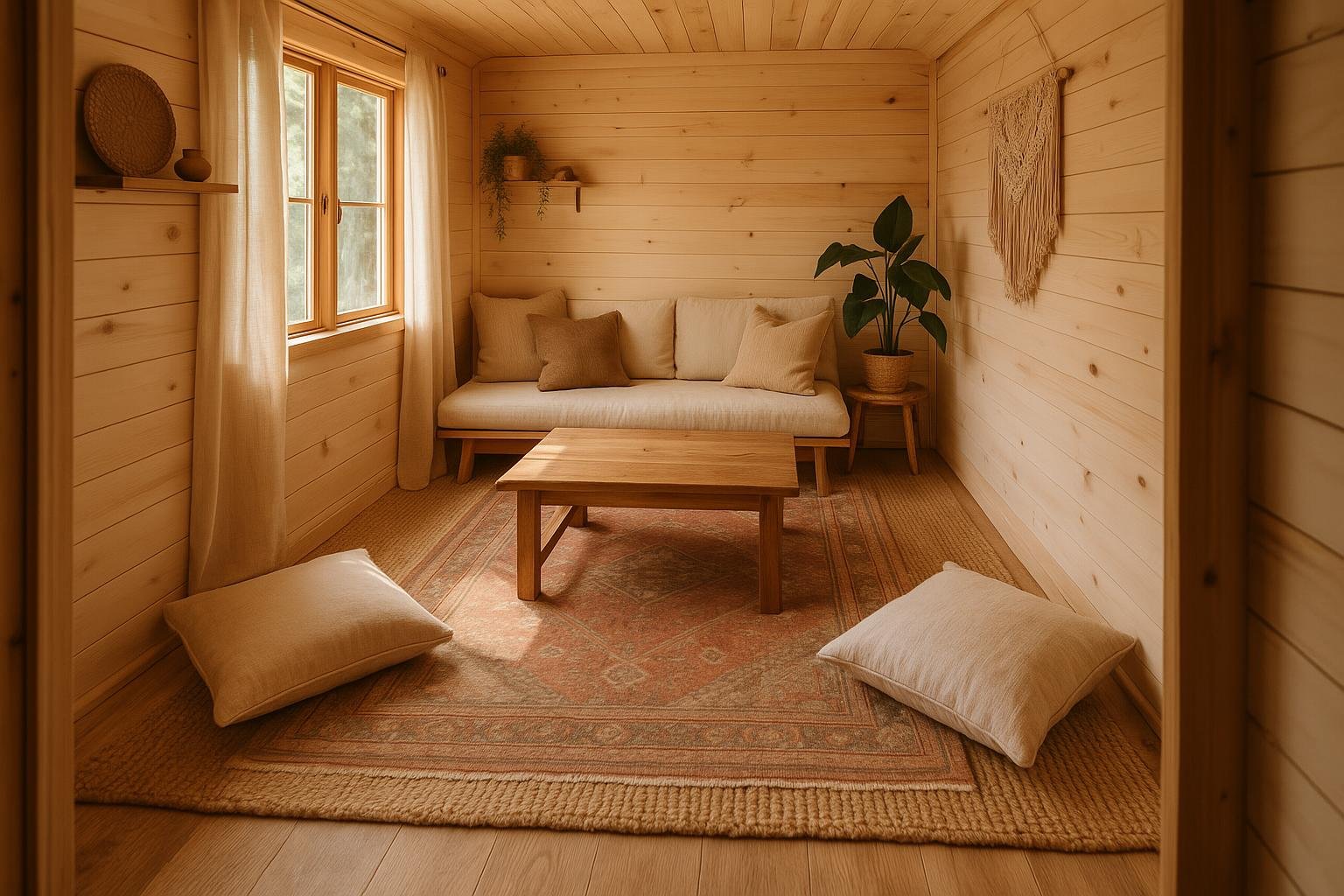
Expert rug layering in a tiny house living room, showcasing how different textures and sizes create depth and visual interest.
Layered rugs represent one of the most distinctive and impactful elements of earthy boho design, creating visual depth, defining spaces, and adding essential warmth and comfort to tiny house interiors. This technique, which involves strategically overlapping rugs of different sizes, textures, and patterns, serves multiple purposes in small spaces, from creating the illusion of larger floor areas to providing practical benefits like sound absorption and thermal insulation.
The foundation of successful rug layering begins with selecting an appropriate base rug that establishes the overall tone and scale for the space. In tiny houses, this base rug should typically be the largest piece in the layering scheme, ideally covering a significant portion of the floor area to create a sense of cohesion and spaciousness. Natural fiber rugs like jute, sisal, or seagrass work exceptionally well as base layers because their neutral tones and organic textures provide a versatile foundation.
The size relationship between layered rugs plays a crucial role in creating visual harmony and preventing the technique from appearing chaotic or overwhelming in small spaces. A general rule for tiny house rug layering involves using rugs that differ in size by at least two feet in each dimension, ensuring clear visual separation between layers while maintaining proportional relationships that feel intentional rather than accidental.
According to Elle Decor, rug layering has become one of the most popular interior design trends, with searches increasing by 200% over the past year. This technique proves particularly valuable in tiny houses where floor space is limited but visual impact is crucial.
Macramé and Fiber Arts for Tiny House Walls Macrame-and-fiber-arts
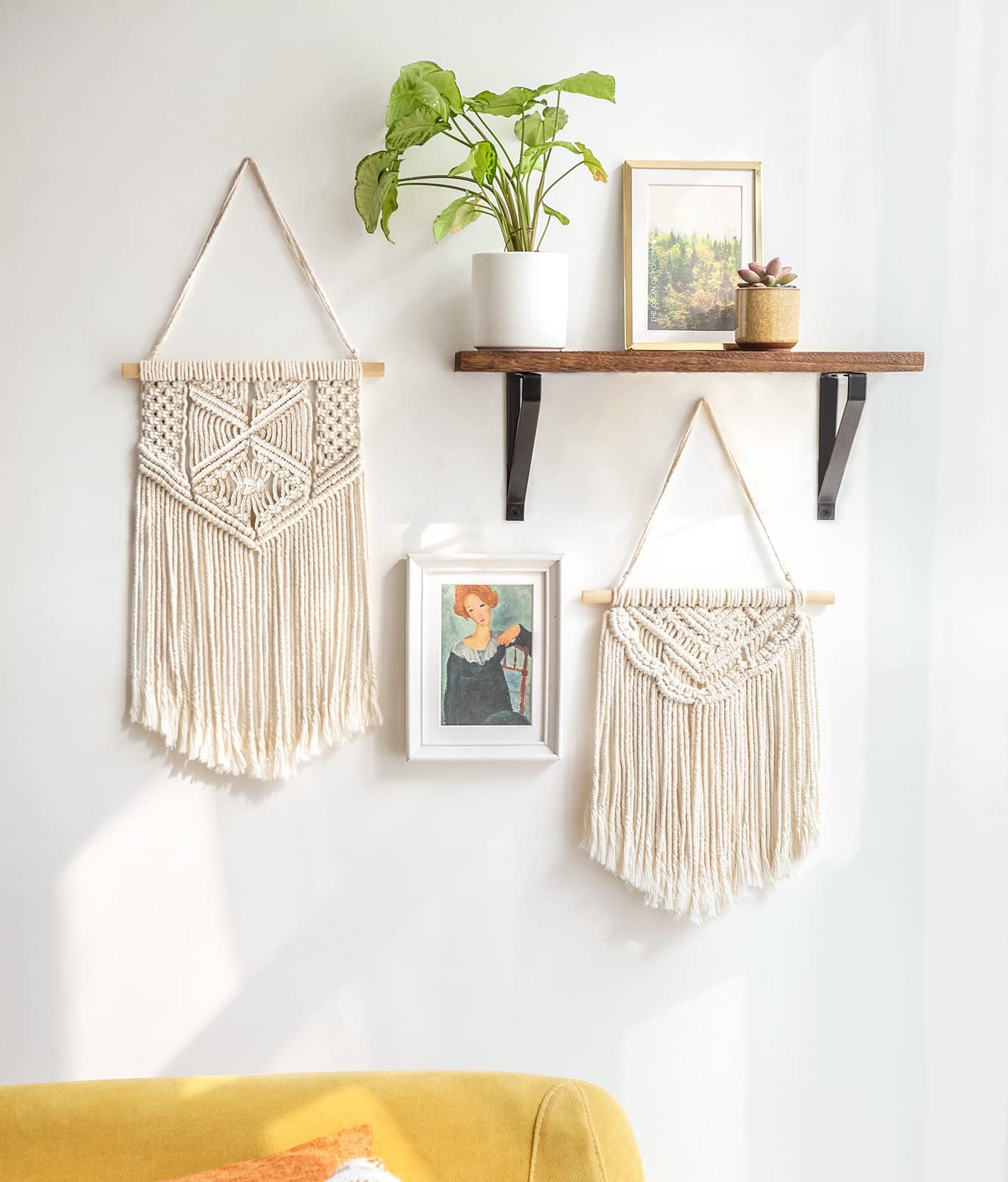
Beautiful macramé wall hangings add texture and handcrafted charm to tiny house interiors.
Macramé and fiber arts represent essential elements of earthy boho design that bring handcrafted beauty, textural richness, and vertical interest to tiny house walls. These ancient crafts, experiencing a remarkable renaissance in contemporary interior design, offer tiny house dwellers unique opportunities to add personality and warmth to their spaces while supporting the style’s emphasis on natural materials and artisanal craftsmanship.
The vertical emphasis of wall-mounted fiber arts proves particularly valuable in tiny houses, where floor space is at a premium but wall space offers opportunities for creative expression. Macramé wall hangings draw the eye upward, creating the illusion of height that can make low-ceilinged tiny houses feel more spacious and airy. This vertical movement also helps balance the horizontal lines that often dominate tiny house interiors.
The natural materials traditionally used in macramé and fiber arts align perfectly with the earthy boho emphasis on organic textures and sustainable design choices. Cotton cord, jute rope, wool yarn, and linen thread all contribute to the natural, earth-connected feeling that defines the style while providing the tactile richness that makes spaces feel warm and inviting.
For those interested in creating their own handcrafted elements, our guide to DIY Tiny House Projects offers step-by-step instructions for various fiber art techniques that can enhance your earthy boho interior.
Indoor Plants: Bringing Nature Inside Small Spaces Indoor-plants-nature

A carefully curated plant vignette showcasing how greenery can transform tiny house interiors.
Indoor plants serve as living, breathing elements that transform earthy boho tiny house interiors from static design schemes into dynamic, evolving environments that change with the seasons and grow more beautiful over time. The integration of plants into small spaces requires strategic thinking about species selection, placement, and care requirements, but the rewards extend far beyond mere aesthetics to include improved air quality, enhanced mental well-being, and the deep satisfaction that comes from nurturing living things.
The air-purifying qualities of indoor plants provide particularly valuable benefits in tiny houses, where limited ventilation and compact living quarters can lead to the accumulation of indoor air pollutants. Plants like snake plants, pothos, and spider plants actively remove toxins from the air while releasing oxygen, creating healthier indoor environments that support the well-being of tiny house residents.
Vertical gardening techniques prove essential for incorporating meaningful plant collections into tiny house interiors without sacrificing precious floor space. Wall-mounted planters, hanging baskets, and tiered plant stands allow for the creation of lush, green environments that draw the eye upward and create the illusion of expanded space.
Research from NASA’s Clean Air Study demonstrates that certain houseplants can remove up to 87% of air toxins within 24 hours, making them particularly valuable in the confined spaces of tiny houses.
Textile Layering Techniques for Maximum Impact Textile-layering-techniques
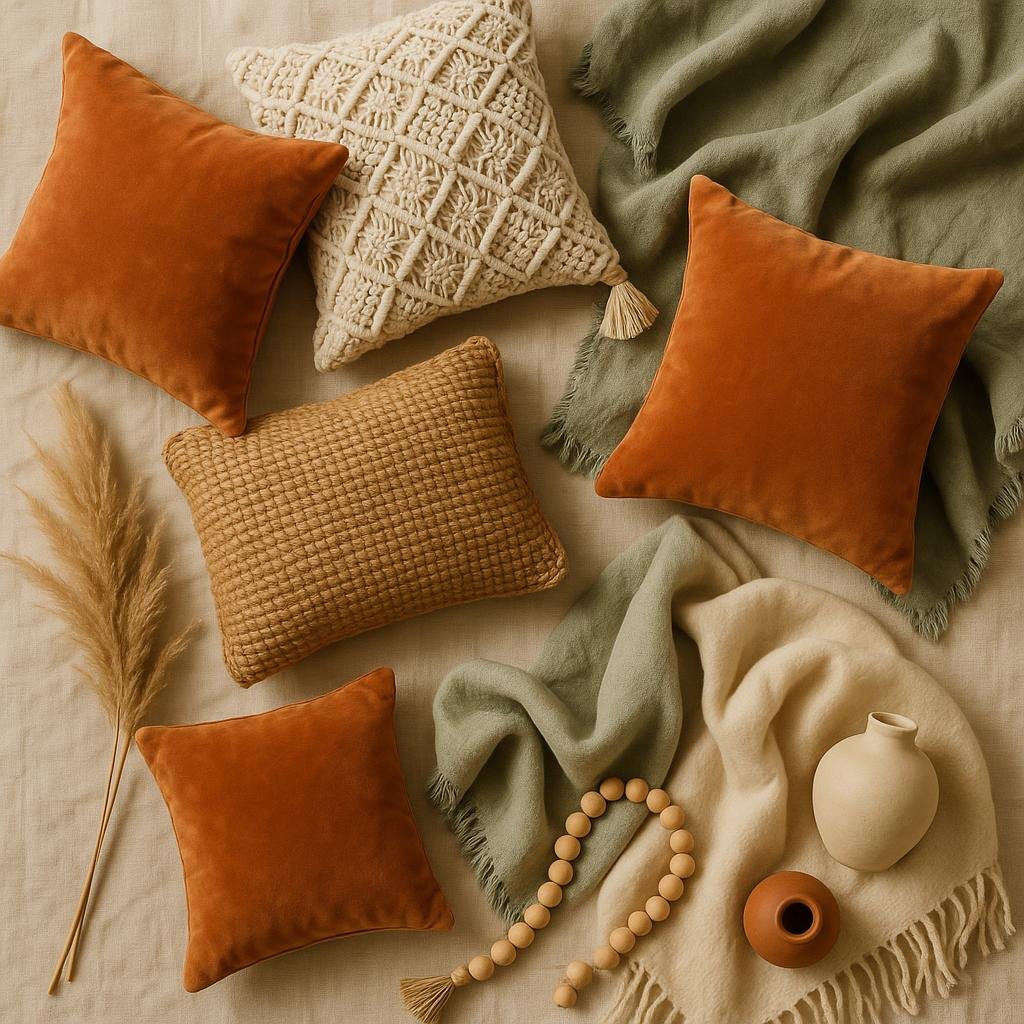
A stunning collection of earthy boho textiles showcasing the variety of textures and colors that define the style.
Textile layering forms the heart of earthy boho design, creating the rich, tactile environment that transforms tiny houses from simple shelters into warm, inviting homes that engage all the senses. This sophisticated technique involves the strategic combination of different fabrics, textures, and patterns to create depth, visual interest, and physical comfort while maintaining the relaxed, organic feeling that defines the style.
The foundation of successful textile layering begins with establishing a cohesive color palette that provides unity while allowing for subtle variations that create depth and interest. Earthy boho layering typically starts with neutral base colors like cream, beige, or soft gray, then builds complexity through the addition of earth tones like terracotta, sage green, and warm brown.
Texture variation provides the primary source of visual and tactile interest in earthy boho textile layering, with the goal of creating rich, complex surfaces that invite touch and exploration. Combining smooth linen with nubby wool, soft cotton with rough jute, and sleek silk with rustic burlap creates dynamic contrasts that engage the senses while maintaining the natural, organic feeling essential to the style.
For comprehensive storage solutions that complement your textile collection, explore our guide to The Ultimate Space-Saving Products & Gadget Guide for Tiny Homes, which includes innovative ways to organize and display your boho textile collection.
Budget-Friendly Boho Decorating Tips Budget-friendly-decorating
Creating stunning earthy boho tiny house interiors doesn’t require unlimited financial resources, as the style’s emphasis on vintage finds, natural materials, and DIY projects naturally lends itself to budget-conscious decorating approaches. The key to successful budget boho decorating lies in understanding which elements provide the greatest visual impact for the least financial investment.
Thrift store and estate sale shopping represents one of the most effective strategies for finding unique, character-rich pieces that define earthy boho style while staying within modest budgets. These venues often yield vintage furniture, decorative objects, and textiles that would cost significantly more when purchased new, while providing the authentic patina and history that mass-produced items cannot replicate.
DIY projects offer unlimited opportunities for creating custom pieces that perfectly fit tiny house spaces while expressing personal creativity and style preferences. Simple projects like macramé wall hangings, painted furniture, and sewn pillow covers can dramatically transform spaces while providing the satisfaction of handcrafted accomplishment.
According to The Spruce, homeowners can achieve professional-looking results on a budget by focusing on high-impact, low-cost changes like textiles, paint, and lighting, which align perfectly with earthy boho design principles.
Bringing It All Together: Complete Room Transformations {complete-room-transformations}
The successful integration of all earthy boho elements into cohesive tiny house interiors requires careful planning, patience, and a clear vision of the desired outcome. The transformation process should be approached systematically, building layers of color, texture, and pattern while maintaining the balance and restraint necessary for successful small space design.
The living area serves as the heart of most tiny houses and provides the greatest opportunity for dramatic earthy boho transformation. Starting with a neutral foundation of paint colors and major furniture pieces, the space can be gradually layered with textiles, plants, and decorative objects that build complexity and interest over time.
For those planning comprehensive tiny house renovations, our article on Family- and Kid-Friendly Tiny House Tips offers valuable insights into creating functional, beautiful spaces that work for all family members.
Conclusion
Earthy boho tiny house interiors represent a perfect marriage of style and practicality, offering a design approach that celebrates natural beauty, sustainable living, and personal expression while addressing the unique challenges of small space living. The 335% increase in searches for “earthy boho living room” reflects a growing desire for authentic, nature-connected interiors that provide refuge from increasingly digital and disconnected modern life.
The key to successful earthy boho tiny house design lies in understanding that every element must serve multiple purposes while contributing to an overall aesthetic that feels both intentional and effortless. From the foundational color palettes that create harmony and spaciousness to the layered textiles that provide comfort and visual richness, each design decision should support both practical living needs and emotional well-being.
The sustainable values inherent in earthy boho design align perfectly with the environmental consciousness that often motivates tiny house living, creating opportunities to build beautiful homes while supporting responsible consumption practices. The emphasis on vintage finds, natural materials, and handcrafted elements not only creates unique, characterful interiors but also supports local artisans and reduces environmental impact.
Perhaps most importantly, earthy boho design celebrates the beauty of imperfection and the value of personal expression, allowing tiny house dwellers to create homes that truly reflect their values, experiences, and dreams. In a world that often prioritizes uniformity and perfection, these authentic, lived-in spaces provide essential reminders of what makes a house truly feel like home.
For more tiny house design inspiration and practical tips, explore our collection of articles on Tiny House Comfort. From outdoor living ideas to space-saving solutions, we’re here to help you create the perfect tiny house sanctuary.
